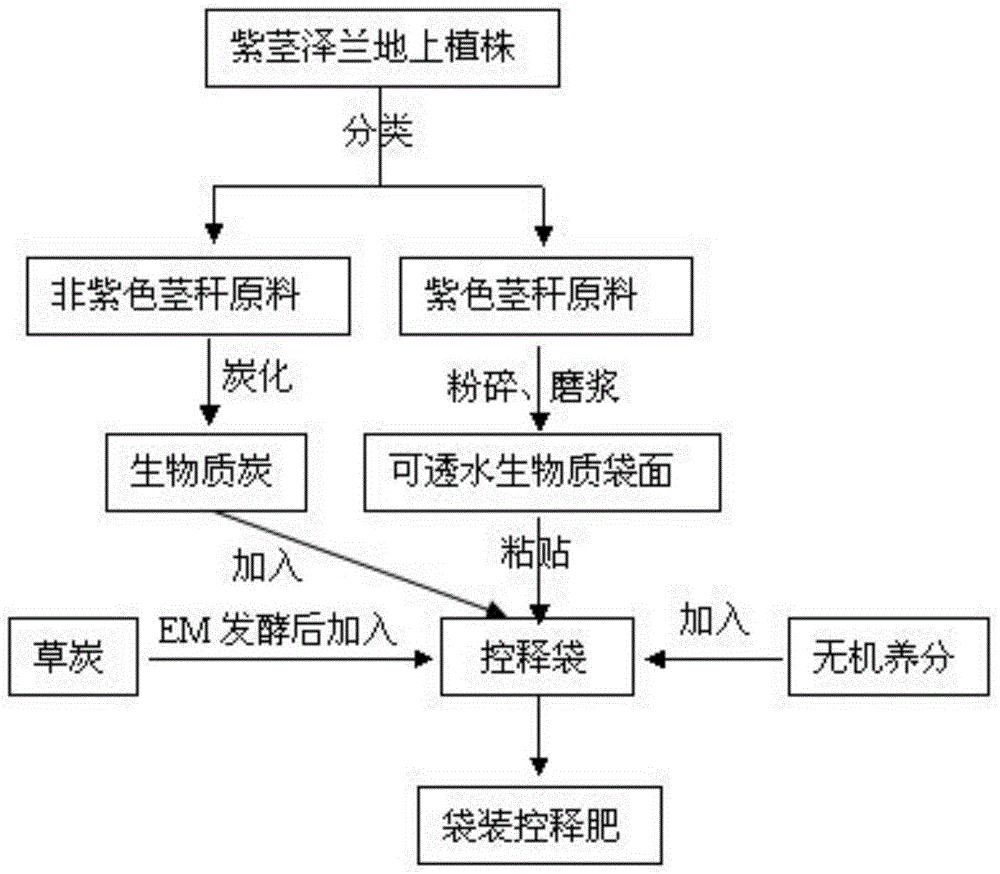Method for preparing bagged controlled-release fertilizer by using Eupatorium adenophorum
A technology of Echinacea and controlled-release fertilizer, applied in bags, applications, sacks, etc., to prevent the loss of leaching nutrients, reduce labor, and reduce top dressing effects
- Summary
- Abstract
- Description
- Claims
- Application Information
AI Technical Summary
Problems solved by technology
Method used
Image
Examples
Embodiment 1
[0050] This example takes Eupatoria adenophorum as an example to prepare special bag-controlled slow-release fertilizer for mango.
[0051] The above-ground plants of Eupatorium adenophorum were collected on the side of the road in Miyi County, Panzhihua City on June 12, 2013. According to the stem color of the above-ground plants of Eupatorium adenophorum, 10 tons of purple stem raw materials were obtained, and 10 tons of non-purple stems were obtained. 40 tons of stalk raw materials.
[0052] 10 tons of purple stalk raw materials are crushed into small sections of 3-5 cm, then placed in a refiner, and 2-3% by weight of biological refining aids are added to grind them into a paste. Then add chitosan and pasty liquid with a weight ratio of 15-30%, place in a mold and press to form the biomass bag surface. Paste the sides of the biomass bag surface and the transparent and degradable biodegradable film bag surface, and sew them into a controlled-release bag with a width of 10 c...
Embodiment 2
[0058] In order to test the fertilizer effect of the bagged controlled-release fertilizer in Example 1, the present embodiment has carried out the fertilization experiment of the 'Haydun' mango adult tree. The specific method is: after picking fruit in the autumn of 2013, fertilize the mango trees in the mango orchard. Apply 10 bags of bagged slow-release fertilizer in embodiment 1, make fertilization rate reach total nitrogen 180kg / hm 2 ,P 2 o 5 150kg / hm 2 、K 2 O160kg / hm 2 . Simultaneously, apply the same nutrients as in Example 1 directly, put them into controlled-release bags prepared by film bags with micropores on the top and bottom, and use no fertilization as a blank control.
[0059] By 2014, the experimental results are as shown in Table 1. As can be seen from the table, when the controlled-release fertilizer nutrient formulation of the present invention is adopted without bagging, the yield per mu is 1.14 times that of no fertilization. When the controlled-rele...
Embodiment 3
[0063] In order to test the controlled-release effect of the bagged controlled-release fertilizer in Example 1, a watering experiment of the bagged controlled-release fertilizer was carried out in this example. In the experiment, two types of controlled-release bags were set, namely: a) the upper and lower surfaces of the biomass bag with micropores and permeable water of the present invention were used; biodegradable film. The two types of bagged fertilizers were placed in 300ml of water for treatment, and the volume of water lost at the bottom of the bag and the nitrogen content in the lost water were collected respectively.
[0064] The experimental results of this embodiment are shown in Table 2. It can be seen from the table that when the lower bag surface of the controlled-release bag is an impermeable film, after watering treatment, a funnel-shaped waterproof structure can be formed, so that the moisture in the running water is only up and down. Both adopt water-permea...
PUM
| Property | Measurement | Unit |
|---|---|---|
| pore size | aaaaa | aaaaa |
Abstract
Description
Claims
Application Information
 Login to View More
Login to View More - R&D
- Intellectual Property
- Life Sciences
- Materials
- Tech Scout
- Unparalleled Data Quality
- Higher Quality Content
- 60% Fewer Hallucinations
Browse by: Latest US Patents, China's latest patents, Technical Efficacy Thesaurus, Application Domain, Technology Topic, Popular Technical Reports.
© 2025 PatSnap. All rights reserved.Legal|Privacy policy|Modern Slavery Act Transparency Statement|Sitemap|About US| Contact US: help@patsnap.com


